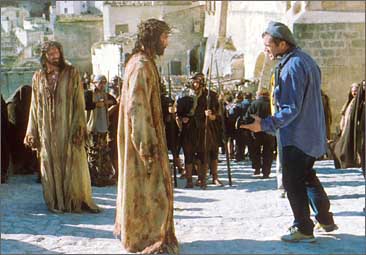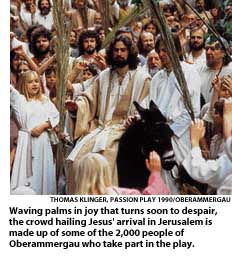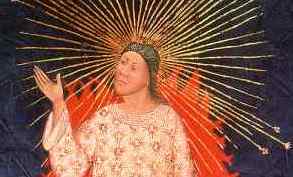 Mel Gibson's portrayal of the final 12 hours of Jesus in his film The Passion of the Christ has been hailed as the gospel truth by some believers, but many scholars complain that it is riddled with historical errors.
Mel Gibson's portrayal of the final 12 hours of Jesus in his film The Passion of the Christ has been hailed as the gospel truth by some believers, but many scholars complain that it is riddled with historical errors.
Scroll to bottom to see movie photo gallery...
 Mel Gibson's portrayal of the final 12 hours of Jesus in his film The Passion of the Christ has been hailed as the gospel truth by some believers, but many scholars complain that it is riddled with historical errors.
Mel Gibson's portrayal of the final 12 hours of Jesus in his film The Passion of the Christ has been hailed as the gospel truth by some believers, but many scholars complain that it is riddled with historical errors.
Their complaints range from inaccuracies about hairstyles and clothes to a lack of gospel context in the film which has raised a furore among Jewish groups who fear its graphic depiction of the crucifixion will fan anti-Jewish violence.
Gibson, who has denied the film is anti-Semitic, has said he consulted scholars, theologians, priests and spiritual writers before scripting the film with the aim of making Jesus's agony during the crucifixion appear as realistic as possible.
Many Christians see the film as bringing them closer to their religion.
Evangelical preacher Billy Graham called the film "a lifetime of sermons in one movie".
Gibson, a traditionalist Catholic who funded the $25 million film himself, was so set on making it authentic that he had his characters speak Latin and Aramaic.
Experts say this was his first mistake as Greek was the language spoken in Jerusalem during Jesus's time, along with Aramaic and some Hebrew spoken by Jews.
"Jesus talking to (Pontius) Pilate and Pilate to Jesus in Latin!" exclaimed John Dominic Crossan, a professor of religious studies at the Chicago-based Roman Catholic De Paul University.
"I mean in your dreams. It would have been Greek."
Latin was reserved for official decrees or used by the elite.
 Most Roman centurions in the Holy Land spoke Greek rather than Latin, according to historians and archaeologists.
Most Roman centurions in the Holy Land spoke Greek rather than Latin, according to historians and archaeologists.
The mistakes, experts say, did not stop with the wrong language, which Professor Crossan, who speaks Latin, said was so badly pronounced in the film that it was almost incomprehensible.
"He has a long-haired Jesus ... Jesus didn't have long hair," said physical anthropologist Joe Zias, who has studied hundreds of skeletons found in archaeological digs in Jerusalem.
"Jewish men back in antiquity did not have long hair."
"The Jewish texts ridiculed long hair as something Roman or Greek," said New York University's Lawrence Schiffman.
 Along with extensive writings from the period, experts also point to a frieze on Rome's Arch of Titus, erected after Jerusalem was captured in AD 70 to celebrate the victory, which shows Jewish men with short hair taken into captivity.
Along with extensive writings from the period, experts also point to a frieze on Rome's Arch of Titus, erected after Jerusalem was captured in AD 70 to celebrate the victory, which shows Jewish men with short hair taken into captivity.
Erroneous depictions of Jesus in Western art have often misled film makers in their portrayal of Jesus, experts said.
 For some scholars the errors go beyond language or hairstyles.
For some scholars the errors go beyond language or hairstyles.
They say the heart of the problem is the film's script which interweaves the literal interpretation of four sometimes contradictory gospel accounts of Jesus' last 12 hours with the visions of a controversial 19th century nun.
"This is my version of what happened, according to the gospels and what I wanted to show," Gibson told the US television network ABC this month.
 But Professor Crossan complained that the lack of historical context was the movie's "basic flaw".
But Professor Crossan complained that the lack of historical context was the movie's "basic flaw".
The film begins not when Jesus enters Jerusalem to the exuberant welcome of thousands of Jews but rather at night in a garden on the eve of the crucifixion when he is arrested by the Romans after being betrayed by Judas.
"Why did they need a traitor? Why did they need the night? Why didn't they grab him in the daytime?" Professor Crossan asked.
"Because they did not want a riot," he said, explaining that Jesus was immensely popular among his fellow Jews, which is why the high priests and Romans felt threatened by him.
Those details, Professor Crossan said, were absent in the film.
"The lack of context is the most devastating thing for anyone who says it (the film) is faithful to the gospels because the gospels have the context," he told Reuters.
 One of the most controversial aspects of the film is its portrayal of Pilate reluctantly sentencing Jesus to crucifixion under pressure from a bullying mob and conniving Jewish priests.
One of the most controversial aspects of the film is its portrayal of Pilate reluctantly sentencing Jesus to crucifixion under pressure from a bullying mob and conniving Jewish priests.
Scholars acknowledge the scene is faithful to the gospels, but some experts say a historical perspective is imperative.
"It is important to see the historical context. Not only for the sake of being true to history but for the sake of being true to the gospel passages themselves," said Father Michael McGarry, rector of the Tantur Ecumenical Institute in Jerusalem.
The gospels, he said, were written many years after the crucifixion at a time when the early Christians felt it would be politically wise to "soften Pontius Pilate as a way of placating" the Romans who ruled over them.
"Pontius Pilate was a very cruel and brutal man. And he wouldn't care two winks about executing another Jew. He had killed so many before him," said Father McGarry, who said he had not seen the film and was commenting only on the history of the time.
From Reuter's news, Wednesday, February 25, 2004
 666 on Christ tickets
disturbs people!
666 on Christ tickets
disturbs people!
 Passion of Christ Photo Gallery
Passion of Christ Photo Gallery
![]()
Return to Reality Carnival.
If you like stories like this, Reality Carnival has many more.